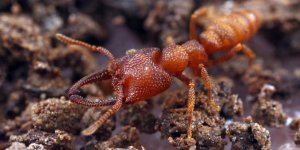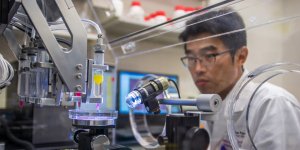Science News

New study revealed that the Dracula ant or Mystrium camillae, has the fastest animal movement on record as it can snap its mandibles at speeds of up to 90 meters per second, which makes it more than 200 miles per hour. »

Attention training improves intelligence and brain function of children. The benefit is greater if the training is guided by an educator, according to recent research conducted at the University of Granada. »

‘Anhedonia’ (the loss of pleasure) is one of the key symptoms of depression. An important component of this symptom is an inability to feel excitement in anticipation of events; however the brain mechanisms underlying this phenomenon are poorly understood. »

Findings reveal tripling of blood levels of trimethylamine N-oxide from red meat diet, but dietary effects can be reversed »

After performing a systematic study of the antimicrobial properties of a toxin normally found in a South American wasp, researchers at Massachusetts Institute of Technology have now created variants of the peptide that are potent against bacteria but nontoxic to human cells »

Researchers have discovered that a hormone, fibroblast growth factor 21, is extremely elevated in mice with liver disease that mimics the same condition in patients with methylmalonic acidemia, a serious genomic disorder. »

A simple molecule in the atmosphere that acts as a "detergent" to breakdown methane and other greenhouse gases has been found to recycle itself to maintain a steady global presence in the face of rising emissions, according to new NASA research. »

Women who experience pregnancy loss and do not go on to have children are at greater risk of cardiovascular disease, such as heart disease and stroke, compared with women who have only one or two children. »

Scientists have found evidence of the infectious agent of sporadic Creutzfeldt-Jakob disease (CJD) in the eyes of deceased CJD patients. The finding suggests that the eye may be a source for early CJD diagnosis and raises questions about the safety of routine eye exams and corneal transplants. »

Researchers from the University of Granada have discovered that the megalithic necropolis of El Barranquete in Níjar prolonged its funerary use throughout the Bronze Age, a thousand years longer than previously thought, and that despite its proximity to the sea, people living there did not make use of marine resources. »

The discovery of fossil teeth from two marsupial species that lived 43 million years ago on what was at that time an island provides key insights into the influence of geological changes on the evolution of mammals. »

An international team of researchers discovered two proteins essential to the development of skeletal muscle. The research, could lead to a better understanding of rare muscular diseases and the development of new treatments. »

Slow-motion collisions of tectonic plates under the ocean drag about three times more water down into the deep Earth than previously estimated, according to a first-of-its-kind seismic study that spans the Mariana Trench, a crescent-shaped trench in the Western Pacific that measures 1,500 miles long and is the deepest ocean trench in the world. »

The nearest single star to the Sun hosts an exoplanet at least 3.2 times as massive as Earth — a so-called super-Earth. »

Many of the chemicals that compose our planet and our bodies were formed directly by stars. »

Scientists have sequenced 15 ancient genomes spanning from Alaska to Patagonia and were able to track the movements of the first humans as they spread across the Americas at “astonishing” speed during the last Ice Age, and also how they interacted with each other in the following millennia. »

An international team of researchers has discovered a large meteorite impact crater hiding beneath more than a half-mile of ice in northwest Greenland. »

Scientists from the University of Granada have studied the so‑called ‘Pinocchio Effect’, which causes the temperature of the nose to decrease between 0.6 ºC and 1.2 ºC while that of the forehead increases between 0.6 ºC and 1.5 ºC when a person is lying. »

Our ability to selectively forget distracting memories is shared with other mammals, suggests new research from the University of Cambridge. »

Scientists have designed a device for testing 'electroceuticals,' or cell-stimulating therapies with induce partial hindlimb regeneration in adult aquatic African clawed frogs (Xenopus laevis) by 'kick-starting' tissue repair at the amputation site. »

A study in mice has shown that it may be possible to detect the early signs of atherosclerosis, which leads to blocked arteries, by looking at how cells in our blood vessels change their function. »

A new study suggests that bacteria may regulate neuronal circuits behind movement in flies. »

USDA-Agricultural Research Service scientists have identified coconut oil fatty acids that have strong repellency and long-lasting effectiveness against ticks, biting flies, mosquitoes and bed bugs. »

Thought cemeteries were only for the dead? Not so, say scientists of the University of Colorado Boulder. They found that graveyards are in fact places of the undead -- in the form of microbes on tombstones. »

It doesn't take long for Freya, a Springer Spaniel with plenty of energy and a very sensitive nose, to find the sock of a child infected with malaria. »

Alkali-resistant ‘sea rice’ planted in east China’s Shandong Province was harvested by Chinese scientists. »

In the first study of its kind, Austrian researchers have tracked the movement of microplastics into human beings. The results show that the plastic that is a ubiquitous element of human life is now also a constant element in the human body. »

The theory that Earth has a solid core has finally been confirmed by scientists after uncertainty lingered over the topic for more than 80 years. »

An unhealthy population of microbes in the mouth triggers specialized immune cells that inflame and destroy tissues, leading to the type of bone loss associated with a severe form of gum disease. »

Earth has the capacity to feed the world’s population on a healthy diet if countries make fundamental changes to their food production systems and consumption, a study has found. »

Barite, a mineral compound of barium, is now a direct and accurate proxy for marine productivity, marine climate, and marine life evolution in general. »

Biomedical engineers have demonstrated that injecting an artificial protein made from a solution of partially ordered protein varieties makes a secure, porous scaffold that may quickly combine into tissue and promote the formation of blood vessels. »

Researchers from the Cambridge Graphene Centre, together with industrial and academic collaborators within the European Graphene Flagship project, showed that integrated graphene-based photonic devices offer a solution for the next generation of optical communications. »

Half of mental health disorders arise before the age of 14, but most cases are not detected or treated until much later, according to the latest data from the World Health Organization. »

The bees are dying in massive numbers and it is mostly caused by a parasite aptly named Varroa destructor, but in a new study, researchers presented mushrooms as evidence for a surprising solution to DWV. »

Researchers from the University of Granada and RMIT University in Melbourne have developed personalised and low-cost wearable ultraviolet (UV) sensors that warn users when their exposure to the sun has become dangerous. »

A team of scientists at the University of Cambridge has developed an artificial mouse embryo-like structure capable of forming the three major axes of the body. »

Scientists have uncovered the genetic basis for the production of domoic acid, a potent neurotoxin produced by certain harmful algae blooms. »

Human species have for the first time captured the surface of an asteroid on video footage by Hayabusa 2 mission to Ryugu. »

Data from NASA's Cassini spacecraft has revealed what appear to be giant dust storms in equatorial regions of Saturn's moon Titan. The discovery makes Titan the third Solar System body, in addition to Earth and Mars, where dust storms have been observed. »

Researchers have developed a genome-editing tool for the potential treatment of mitochondrial diseases: serious and often fatal conditions which affect 1 in 5,000 people. »

Mammals are unique in many ways. We're warm-blooded and agile in comparison with our reptilian relatives. But a new study suggests we're unique in one more way -- the makeup of our spines. »

Researchers discovered the means by which honeybees keep their temporary clumps intact during adverse weather conditions, confirming their theory about bees’ behavior under stressful conditions. »

Researchers at the University of Cambridge and the University of Oxford have discovered a new molecule that plays a key role in the immune response that is triggered by influenza infections. »

In a large clinical trial to determine the risks and benefits of daily low-dose aspirin in healthy older adults without previous cardiovascular events, aspirin did not prolong healthy, independent living (life free of dementia or persistent physical disability). »

Neurons absorb and release water when they relay messages throughout the brain, according to a study by researchers at the National Institutes of Health and other institutions. »

Researchers investigating the effects of air pollution conducted tests on more than 25,000 people in 162 Chinese counties and found that pollution is linked to a significant decline in cognition, and that the impact increases with age. »

Three new species of fish, aptly named Pink, Purple and Blue for their coloring, have been found at the bottom of one of the deepest parts of the Pacific Ocean. »

German scientists discovered that a herbal ingredient from traditional Chinese medicine showed promising results in weight loss. »

The quest to find new ways to harness solar power has taken a step forward after researchers successfully split water into hydrogen and oxygen by altering the photosynthetic machinery in plants. »


